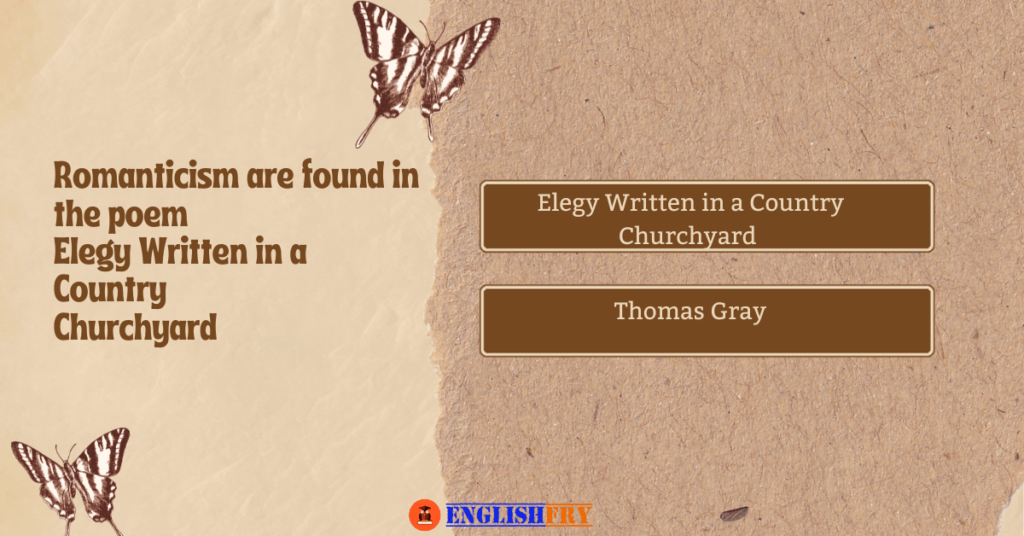‘Elegy Written in a Country Churchyard’, one of the five most famous elegies in English literature, is written by Thomas Gray who was the poet of the transitional period between Neo-classic and Romantic. For this reason, he was influenced by both the literary ideals of these periods. In this poem, we see that he follows some of the characteristics from each of romanticism and neo-classicism. At the side of use and presentation of language, he, we can consider, maintains the neo-classic ideals, and at the side of theme and setting, it is romantic. So, this elegy is very important in both theme and style, out of the most famous elegies. Now, we will see how Gray has mingled both the characteristics.
At first we will discuss the neo-classic characteristics of the poem:
The language and the poets emotion in the period are restrained in various literary rules. The neo-classic writers are attentive to make their work perfect- perfection of style is their belief to write poetry. In ‘Elegy Written in a Country Churchyard’, the whole poem of 128 lines falls into 32 stanzas. Each stanza contains the same style – each of the line is iambic pentameter. Again, his emotion is also restrained in each stanza.
In neo-classical literature, personification is frequently seen. In the same way, we, in this poem, see that Gray uses many abstract words like the living persons, and often places them as the subjects of the verbs. There is a capital letter at first of each of them. For instances- Ambition, Grandeur, Memory, Honour, Flattery, Knowledge, Penury, Luxury Pride, Muse, Forgetfulness, Nature, Ashes, Youth, Fortune, Fame, Science, Melancholy and Misery. We can mention the first stanza of the poem epitaph –
Here rests his head upon the lap of Earth
A Youth to Fortune and to Fame unknown.
Fair Science frowned not on his humble birth,
And Melancholy marked him for her own.
Or,
Can Honour’s voice provoke the silent dust
Or Flatting sooth the dull could ear of death?
Addressing by apostrophe is another technique of neo-classic literature. In this poem; we also see apostrophe-
Nor you, ye proud impute to these the fault………….
Or.
For thee, who, mindful of the unhonoured dead……
Or,
Approach and read (for thou canst read) the lay….
Moralizing is very common in neo-classism. In this poem, the poet moralizes that: the rich city people should not mock at the poor village people and should not be proud of their high birth and position, beauty and wealth, because the ultimate fate of every man is same. All have to go to the grave. The most famous line of the poem is ‘The paths of glory lead but to the grave’
Harmony is maintained in neo-classic literature. This elegy is circular to the poets himself- he begins with his own self and ends with his own epitaph-but contains other things also- the poor forefathers of the village, contrasting with the rich city people- so this poem is a symbol of complete harmony.
Now, we will discuss about the romantic elements of the poem:
At first, subjectivity is the most important element in romantic literature. In the same way, we see that the poet ends the first stanza- begins the poem- with the subjective word ‘me’-
‘And leaves the world to darkness and to me’
Again, he ends this poem with his own epitaph that will, in future, be read beside his grave. So this poem is circular from/with subjectively to subjectivity.
The main theme of the poem is death we can consider to be the romantic element. Here, at the first stanza, the ‘parting day’(evening) and the ‘darkness’ are the symbols of the death. Then the poet mentions about death of the forefathers of the village, and at last the thought of his own death.
Nature is the vital element of romanticism. In this poem, from beginning to end, the poet’s description possesses nature. Then, village is the symbol of nature, and he shows the superiority of the village and villagers. Moreover, his most of the imageries are taken from nature. For example,
The lowing herd wind slowly over the lea
The plowman home ward plods his weary way
Besides, there are owl’s complaint, twittering of swallow, loud and shrill crowing of cock, the echoing horn of the hunt man and so on. Here one thing can be mentioned that in neo-classic literature nature was almost absent. For instances, in the ‘Rape of the Lock’ written by pope, representative of the age, nature was absolutely absent.
Again, the poet is standing in such an atmosphere where silence and loneliness that are the romantic elements exists.
From beginning to the end, the mode of the poem is melancholic which is also a romantic characteristic. Even, Gray uses some symbols of melancholy, such as- ‘elm tree’, and ‘yew-tree’.
In fine, it can be said that, Thomas Gray very brilliantly mixes both the neo-classic and romantic characteristics in this poem. Though it is essentially a subjective work, it has a universal appeal to the readers. Because, the main theme of the poem is such a thing that must come in every man’s life. Besides, every man wants to be remembered after his of her death. For this reason, this elegy is important and different from other famous elegies.
Founder of Englishfry.com, a captivating and knowledge-driven blog & Founder of Android app/website Studyfunnel.com, an online Mock Test Series Portal. With a wealth of experience spanning over 16+ years, he has excelled as an Ex-Asst.Professor, Teacher, Amazon published author, Website Developer, Graphic Designer,Blogger,Poet, and Creative academic content writer publisher of 4 academic books. His tryst in Literature helped him realize his love for writing and telling stories. A tech-savvy language nerd by day and, a passionate writer by night, he now translates his experiences into tales of wisdom served with a side of humor.His widely recognized profound insights ,captivating writing style of weaving words make him contribute to prestigious publications and a sought-after authority in the field that transport readers to extraordinary worlds.








